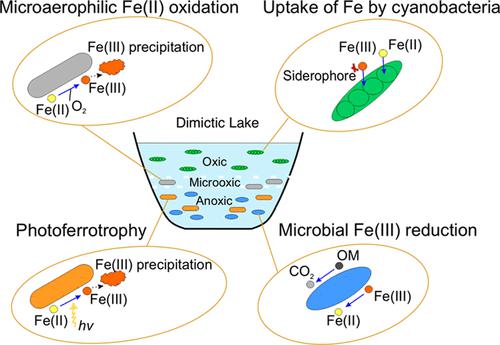当前位置:
X-MOL 学术
›
Environ. Sci. Technol.
›
论文详情
Our official English website, www.x-mol.net, welcomes your
feedback! (Note: you will need to create a separate account there.)
Large Fractionation in Iron Isotopes Implicates Metabolic Pathways for Iron Cycling in Boreal Shield Lakes
Environmental Science & Technology ( IF 10.8 ) Pub Date : 2022-09-26 , DOI: 10.1021/acs.est.2c04247 Kai Liu 1, 2 , Sherry L Schiff 1, 2 , Lingling Wu 1, 2 , Lewis A Molot 3 , Jason J Venkiteswaran 4 , Michael J Paterson 5 , Richard J Elgood 1, 2 , Jackson M Tsuji 6 , Josh D Neufeld 2, 6
Environmental Science & Technology ( IF 10.8 ) Pub Date : 2022-09-26 , DOI: 10.1021/acs.est.2c04247 Kai Liu 1, 2 , Sherry L Schiff 1, 2 , Lingling Wu 1, 2 , Lewis A Molot 3 , Jason J Venkiteswaran 4 , Michael J Paterson 5 , Richard J Elgood 1, 2 , Jackson M Tsuji 6 , Josh D Neufeld 2, 6
Affiliation

|
Stable Fe isotopes have only recently been measured in freshwater systems, mainly in meromictic lakes. Here we report the δ56Fe of dissolved, particulate, and sediment Fe in two small dimictic boreal shield headwater lakes: manipulated eutrophic Lake 227, with annual cyanobacterial blooms, and unmanipulated oligotrophic Lake 442. Within the lakes, the range in δ56Fe is large (ca. −0.9 to +1.8‰), spanning more than half the entire range of natural Earth surface samples. Two layers in the water column with distinctive δ56Fe of dissolved (dis) and particulate (spm) Fe were observed, despite differences in trophic states. In the epilimnia of both lakes, a large Δ56Fedis-spm fractionation of 0.4–1‰ between dissolved and particulate Fe was only observed during cyanobacterial blooms in Lake 227, possibly regulated by selective biological uptake of isotopically light Fe by cyanobacteria. In the anoxic layers in both lakes, upward flux from sediments dominates the dissolved Fe pool with an apparent Δ56Fedis-spm fractionation of −2.2 to −0.6‰. Large Δ56Fedis-spm and previously published metagenome sequence data suggest active Fe cycling processes in anoxic layers, such as microaerophilic Fe(II) oxidation or photoferrotrophy, could regulate biogeochemical cycling. Large fractionation of stable Fe isotopes in these lakes provides a potential tool to probe Fe cycling and the acquisition of Fe by cyanobacteria, with relevance for understanding biogeochemical cycling of Earth’s early ferruginous oceans.
中文翻译:

铁同位素的大分馏与北方盾湖中铁循环的代谢途径有关
稳定的 Fe 同位素最近才在淡水系统中进行测量,主要是在 meromictic 湖泊中。在这里,我们报告了两个小型北方盾状源头湖泊中溶解、颗粒和沉积物 Fe的 δ 56 Fe:经过处理的富营养化 Lake 227,每年都有蓝藻水华,以及未经处理的贫营养化 Lake 442。在湖泊内,δ 56 Fe的范围很大(大约 -0.9 到 +1.8‰),跨越了整个自然地球表面样本范围的一半以上。尽管营养状态存在差异,但在水柱中观察到两层具有独特的溶解 (dis) 和颗粒 (spm) Fe δ 56 Fe。在两个湖泊的表皮层中,一个大的 Δ 56 Fe dis-spm仅在 227 湖的蓝藻大量繁殖期间观察到溶解和颗粒 Fe 之间 0.4-1‰ 的分馏,这可能受蓝藻对同位素轻铁的选择性生物摄取的调节。在两个湖泊的缺氧层中,来自沉积物的向上通量在溶解的铁池中占主导地位,明显的 Δ 56 Fe dis-spm分馏为 -2.2 至 -0.6‰。大 Δ 56 Fe dis-spm之前发表的宏基因组序列数据表明,缺氧层中活跃的 Fe 循环过程,例如微需氧 Fe(II) 氧化或光致铁营养,可以调节生物地球化学循环。这些湖泊中稳定铁同位素的大量分离为探测铁循环和蓝藻获取铁提供了潜在工具,这与了解地球早期含铁海洋的生物地球化学循环有关。
更新日期:2022-09-26
中文翻译:

铁同位素的大分馏与北方盾湖中铁循环的代谢途径有关
稳定的 Fe 同位素最近才在淡水系统中进行测量,主要是在 meromictic 湖泊中。在这里,我们报告了两个小型北方盾状源头湖泊中溶解、颗粒和沉积物 Fe的 δ 56 Fe:经过处理的富营养化 Lake 227,每年都有蓝藻水华,以及未经处理的贫营养化 Lake 442。在湖泊内,δ 56 Fe的范围很大(大约 -0.9 到 +1.8‰),跨越了整个自然地球表面样本范围的一半以上。尽管营养状态存在差异,但在水柱中观察到两层具有独特的溶解 (dis) 和颗粒 (spm) Fe δ 56 Fe。在两个湖泊的表皮层中,一个大的 Δ 56 Fe dis-spm仅在 227 湖的蓝藻大量繁殖期间观察到溶解和颗粒 Fe 之间 0.4-1‰ 的分馏,这可能受蓝藻对同位素轻铁的选择性生物摄取的调节。在两个湖泊的缺氧层中,来自沉积物的向上通量在溶解的铁池中占主导地位,明显的 Δ 56 Fe dis-spm分馏为 -2.2 至 -0.6‰。大 Δ 56 Fe dis-spm之前发表的宏基因组序列数据表明,缺氧层中活跃的 Fe 循环过程,例如微需氧 Fe(II) 氧化或光致铁营养,可以调节生物地球化学循环。这些湖泊中稳定铁同位素的大量分离为探测铁循环和蓝藻获取铁提供了潜在工具,这与了解地球早期含铁海洋的生物地球化学循环有关。











































 京公网安备 11010802027423号
京公网安备 11010802027423号